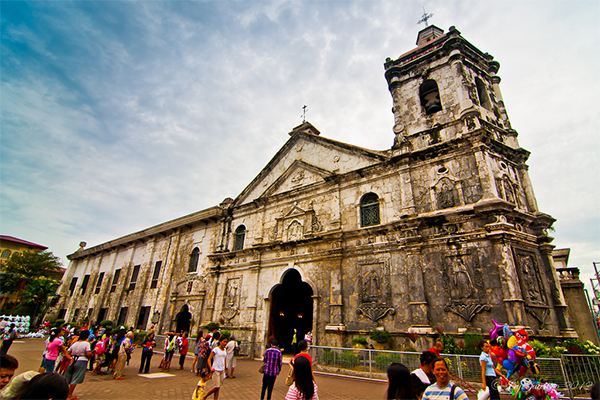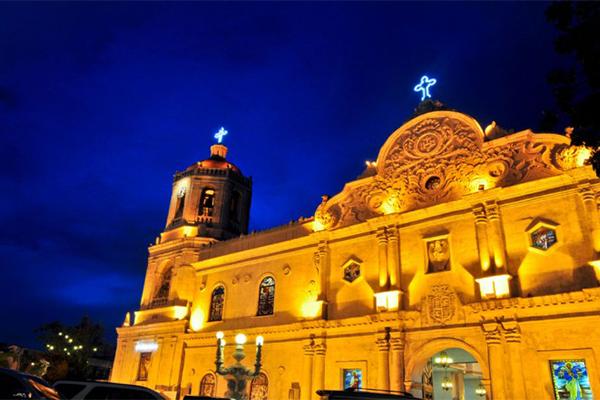Basilica Del Sto. Niño

The convent of the Sto. Niño de Cebu was founded by Fr. Andres de Urdaneta on April 28, 1565 , the very day the Legazpi-Urdaneta expedition arrived in the island. On May 8 of the same year, when Legaspi and his men planned the urbanization of the city, they allotted a “place for the church and the convent of San Agustin, “where the Santo Niño image had been found.”
The church has always been the Sanctuary of the Sto. Niño, under the custody of the Augustinians. The number of priests assigned to the church varied from three to five aside from one or two lay brothers.
Magellan’s Cross
 The Cross of Magellan is a popular historical landmark and tourist attraction in the middle of busy Magellan’s Street. This important symbol of Cebu was planted by Magellan in April 14, 1521 when he baptized the first Christian Filipinos, RajahHumabon and Queen Juana and about 400 followers into the Catholic faith.
The Cross of Magellan is a popular historical landmark and tourist attraction in the middle of busy Magellan’s Street. This important symbol of Cebu was planted by Magellan in April 14, 1521 when he baptized the first Christian Filipinos, RajahHumabon and Queen Juana and about 400 followers into the Catholic faith.
The crypt’s ceiling is beautifully painted with a scene depicting the landing of Magellan in Cebu in 1521 and the planting of the original cross on the shore. Among the devotees it is an old practice to drop coins or put light candles at the foot
of the cross.
Cebu Taoist temple

Taoist temple is located near a very posh suburb of Cebu called, Beverly Hills. It’s about an hour away from the city proper and it has proved to be very convenient location for the Chinese people who usually the residential owners of the subdivision. Today, though, it’s also a famous destination of Koreans, who share the same faith as the Chinese.
Fort San Pedro
 Fuerza San Pedro, the fort is described as built of stone mortar with a terraplein where guns are mounted. The fort contains the necessary buildings. The largest of these buildings was the “Cuerpo de Guardia” where the personnel that manned the fort lived. Adjacent to it was the “Vivende del Teniente” which was the living quarters of the lieutenant of the Fort. In between the aforementioned buildings is a well.
Fuerza San Pedro, the fort is described as built of stone mortar with a terraplein where guns are mounted. The fort contains the necessary buildings. The largest of these buildings was the “Cuerpo de Guardia” where the personnel that manned the fort lived. Adjacent to it was the “Vivende del Teniente” which was the living quarters of the lieutenant of the Fort. In between the aforementioned buildings is a well.
At one corner attached to the walls of the bastion San Miguel (NE) was the “Alamazaros del Rivera” (powder magazine where the fort’s supply or arms and gunpowder from Manila were stored).
Cebu Metropolitan Cathedral

The architecture of the church is typical of Spanish colonial churches in the country, namely, squat and with thick walls to withstand typhoons and other natural calamities. The facade features a trefoil-shaped pediment, which is decorated with carved relieves of floral motifs, an IHS inscription and a pair of griffins. The Spanish Royal Coat of Arms is emblazoned in low relief above the main entrance, reflecting perhaps the contribution of the Spanish monarch to its construction.
Museo de Sugbo

This centuries-old structure was designed in 1869 and was conceived in 1870 by Domingo de Escondrillas, a Spanish architect in Cebu. It was called Carcel de Cebu originally intended to be the main prison for the Visayas. More buildings were added during its renovation in 1892. It became the Cebu City jail from 1946 to 2004. It served its purpose until the provincial government built a much bigger and modern prison (Cebu Provincial Detention and Rehabilitation Center) at Barangay Kalunasan, Cebu City.
Cathedral Museum of Cebu

The Cathedral Museum was initially used as the Cathedral Rectory, or as a convent for the priests, before it was used as a campus for the University of San Carlos. In the years before it was transformed into a museum, it was also used as a cooperative store and as a temporary chapel while the Cathedral was undergoing a renovation. The bahay-na-bato is actually one of a few existing structures in the downtown area that survived World War II.
Sky Experience Adventure

Uniquely the world’s very first and only amusement ride of its kind, the Edge Coaster goes around the edge of the building while riders are locked onto a rail seat. High above at the 38th floor of the tower, riders can indulge in a breathtaking panorama of the entire Cebu landscape 130.84 meters above ground.
